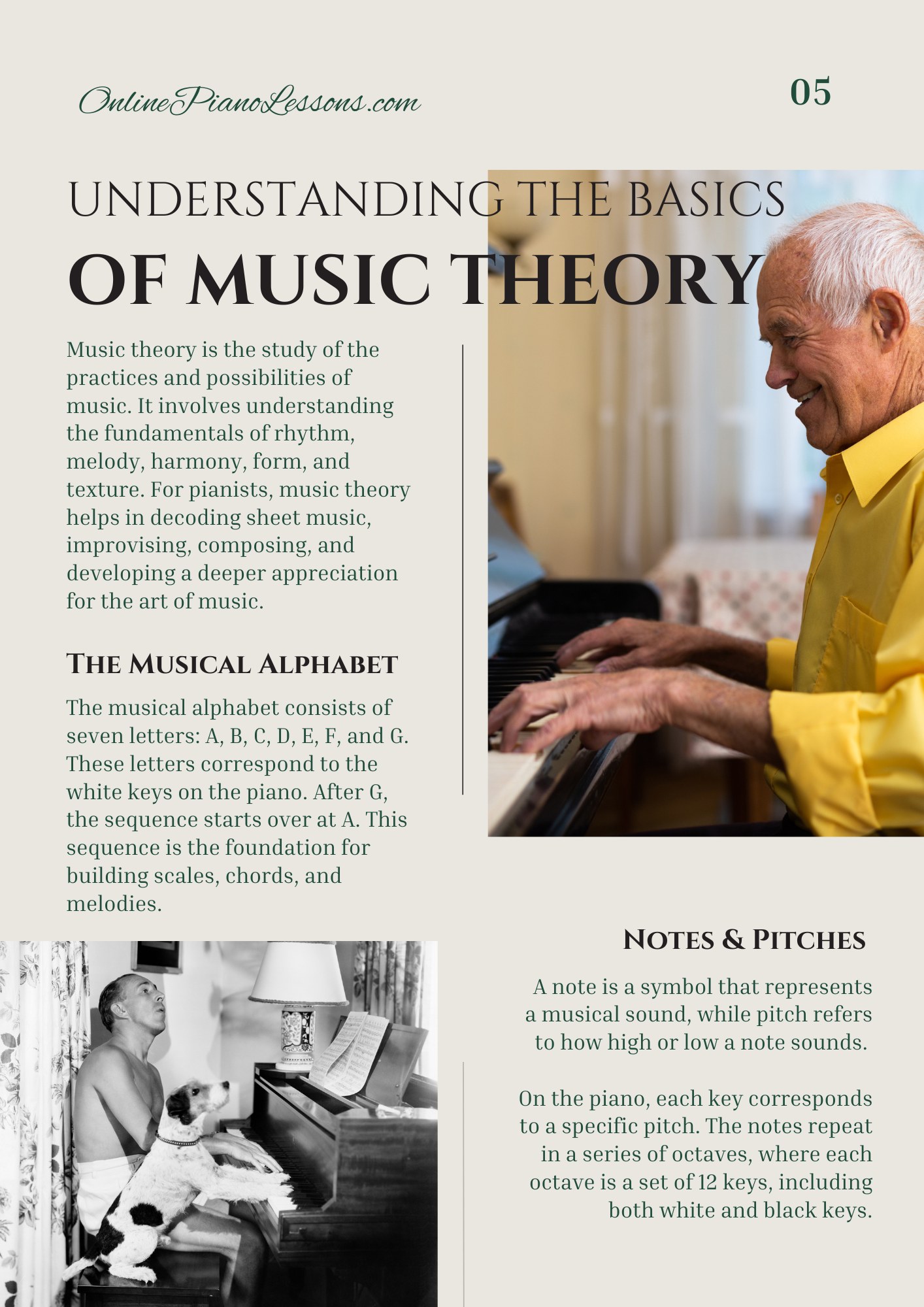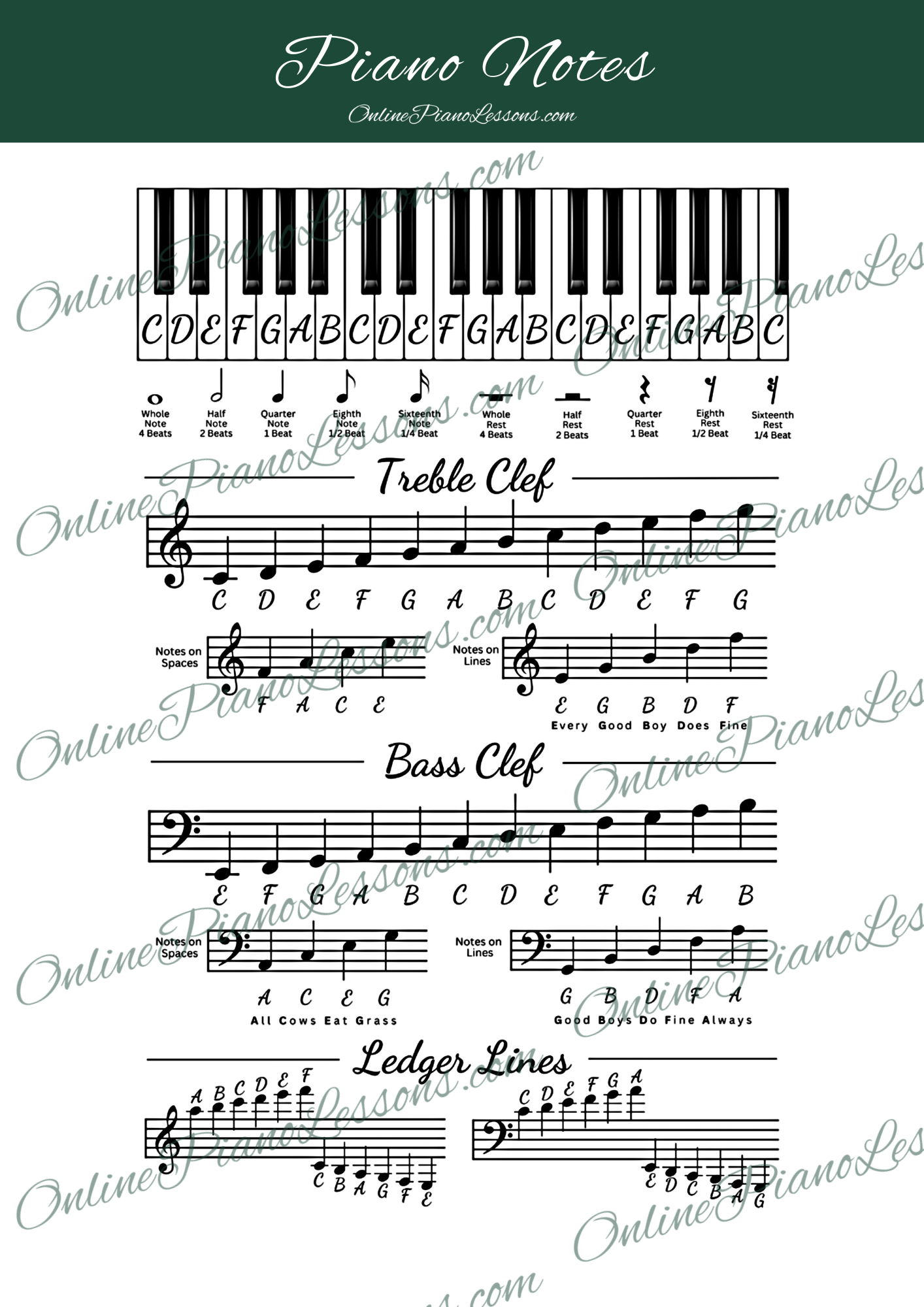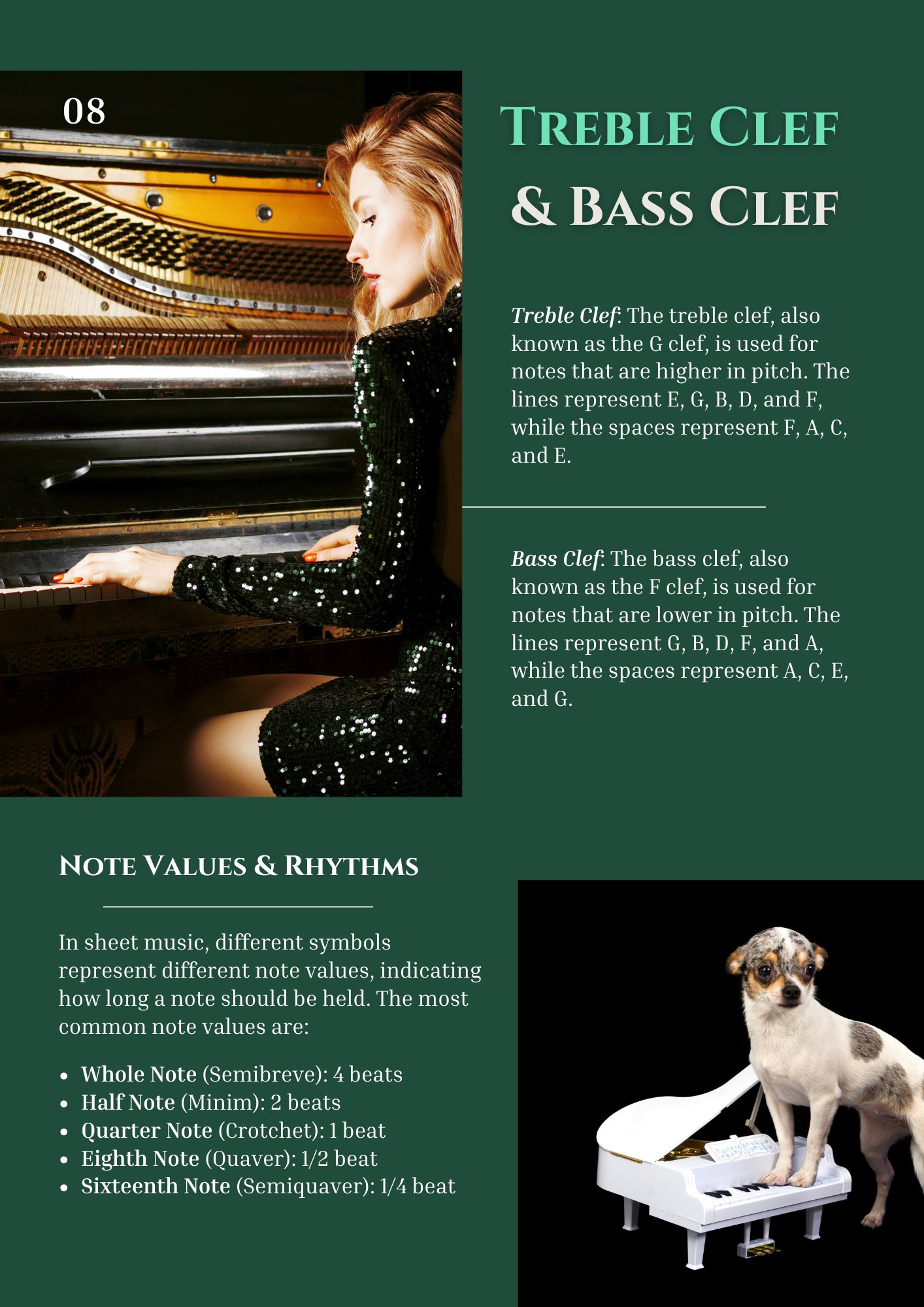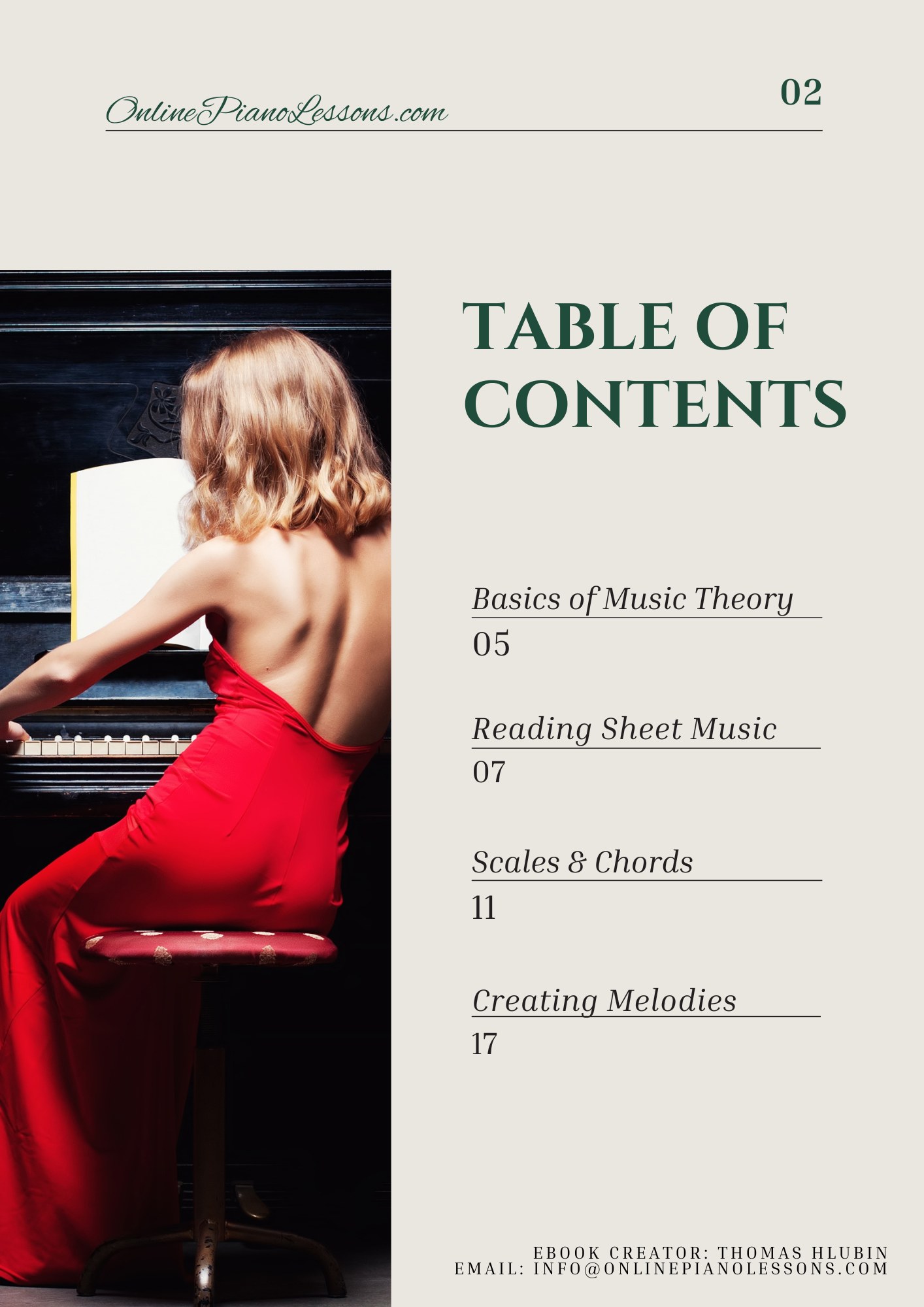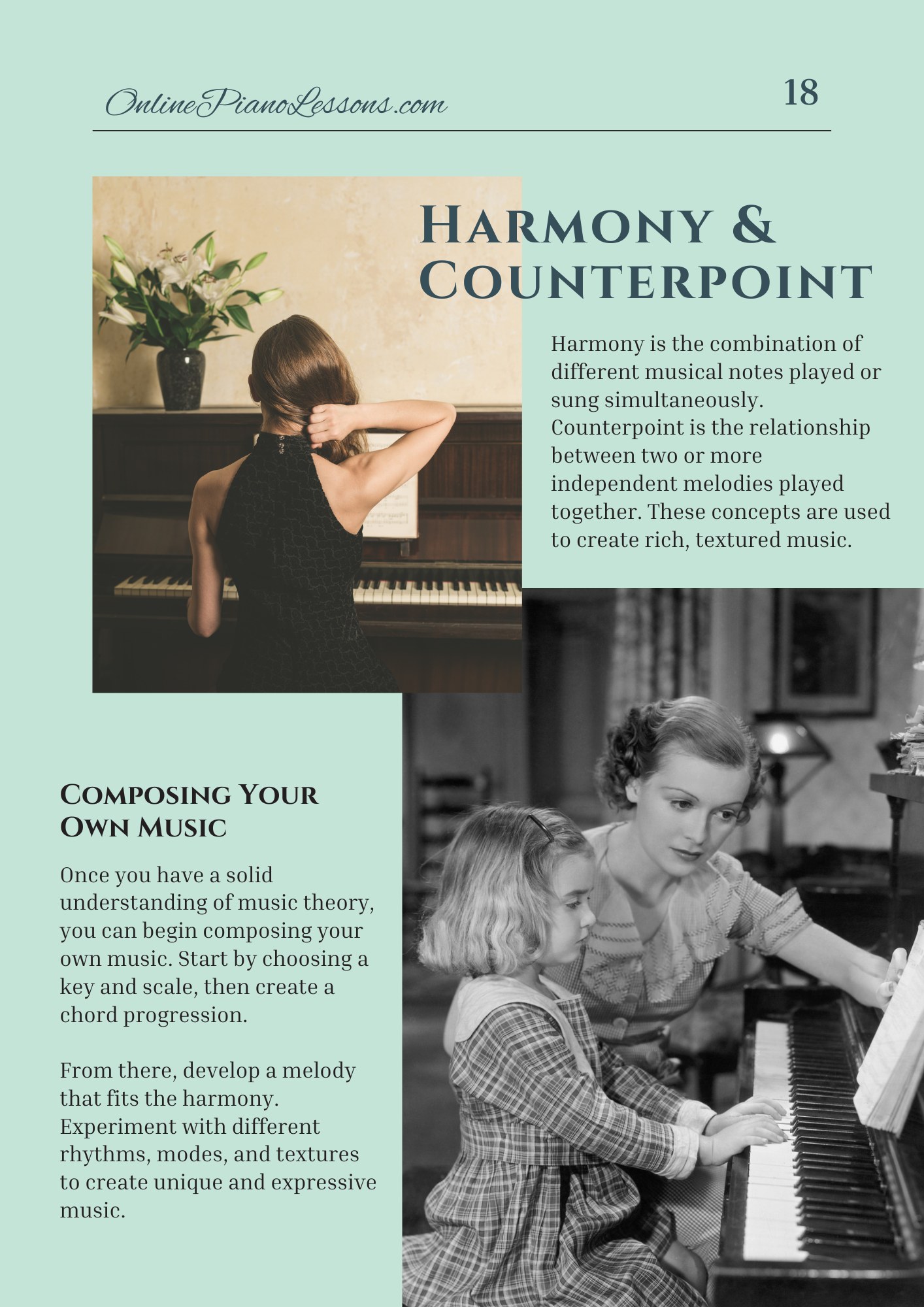✅ Learn Piano + Get 25% off of my online Piano for Beginners Course! Enjoy and happy playing!
If you want to play piano with confidence, read music faster, and improvise without guesswork, you need piano scales. Scales are the grammar of music—the recurring patterns that show up in melodies, bass lines, and chord progressions in every style. In this definitive guide, you’ll learn what piano scales are, why they matter, how major and minor scales work, and how to practice them so you actually improve. We’ll also list all major and minor scales with their correct note spellings so you can get straight to the keys.
Major & Minor Piano Scales
What are Piano Scales?
At their simplest, piano scales are ordered sequences of notes that move stepwise up or down, usually covering an octave (eight scale degrees) before repeating. Each scale is built from a pattern of whole steps (two semitones) and half steps (one semitone).
These patterns create the characteristic sound (or “mode”) of a key. Because piano scales organize the keyboard’s 12 notes into predictable patterns, they’re the fastest way to learn finger coordination, key signatures, and the sounds of different tonalities.
Why Piano Scales Matter
- Technique you can use: Practicing piano scales builds evenness, finger independence, wrist alignment, and velocity.
- Key fluency: Every key feels different under your hands. Running piano scales daily means fewer surprises when a new piece modulates.
- Sight-reading & ear-training: When you recognize scale fragments, you read and play more accurately because your brain anticipates what comes next.
- Improvisation & songwriting: Most melodies lean on scale tones. Knowing piano scales turns improvisation into a guided exploration instead of a maze.
- Theory in motion: Chords are built from scales. Learn the scale; you’re halfway to understanding chord functions and progressions.
How Major and Minor Scales Work
- Major scale formula: W–W–H–W–W–W–H (W = whole step, H = half step).
Example in C major: C–D–E–F–G–A–B–C. - Natural minor scale formula: W–H–W–W–H–W–W.
Example in A natural minor: A–B–C–D–E–F–G–A. - Harmonic minor (for context): Natural minor with a raised 7th (sounds “classical,” exotic).
Example: A–B–C–D–E–F–G♯–A. - Melodic minor (for context): Ascending: raise 6th and 7th; descending: return to natural minor.
Example ascending A melodic minor: A–B–C–D–E–F♯–G♯–A; descending uses F and G natural.
You’ll mostly practice two-octave (or more) piano scales hands together with consistent fingering. Major and natural minor are the core; harmonic and melodic minor are stylistic variations used in repertoire and solos.
All 12 Major Scales (with Note Names)
Tip: Each major scale pairs with a relative minor (same key signature). I’ve listed the majors here and their natural minors in the next section.
- C major: C D E F G A B C
- The C major scale is the foundation of Western music theory—no sharps or flats, just the white keys on the piano. It’s often the first scale beginners learn because it helps you visualize intervals and hand positions clearly. Many classical and pop melodies are based in C major due to its simplicity and bright, open sound.
- G major: G A B C D E F♯ G
- G major introduces one sharp (F♯), marking your first step into key signatures beyond C. The presence of F♯ gives the scale a sparkling quality, commonly used in folk songs, film music, and guitar-friendly pieces. Practicing G major helps strengthen your hand positioning for scales that move slightly beyond the white keys.
- D major: D E F♯ G A B C♯ D
- With two sharps (F♯ and C♯), D major expands your understanding of black-key usage. Its tone is brilliant and uplifting, and it’s a favorite for violin and orchestral compositions because of its resonant tuning. Pianists often notice that D major feels particularly comfortable due to the natural hand shape over black keys.
- A major: A B C♯ D E F♯ G♯ A
- A major includes three sharps and radiates warmth and clarity. It’s often chosen for lyrical, melodic pieces and romantic-era works. On piano, the alternation between white and black keys in this scale helps develop fluid wrist motion and hand coordination.
- E major: E F♯ G♯ A B C♯ D♯ E
- Four sharps define the E major scale, giving it a bright, resonant sound. It’s frequently used in expressive music because of its singing tonal quality. Pianists find that the alternating white and black key pattern promotes smooth, ergonomic movement across octaves.
- B major: B C♯ D♯ E F♯ G♯ A♯ B
- With five sharps, B major looks intimidating at first—but it actually fits the hand beautifully. The natural curve of your fingers aligns well with the black keys, making it surprisingly comfortable to play once learned. It’s often used for rich, full-bodied piano pieces and grand hymn settings.
- F♯ major: F♯ G♯ A♯ B C♯ D♯ E♯ F♯
- Six sharps give this scale a shimmering brilliance. F♯ major has a distinctive character—radiant and forward-moving. Many composers, including Chopin and Debussy, have used it to create luminous, flowing textures. Mastering F♯ major reinforces finger independence and black-key control.
- D♭ major: D♭ E♭ F G♭ A♭ B♭ C D♭
- D♭ major contains five flats and offers a lush, warm timbre. It’s often associated with expressive, emotional music and is a favorite for lyrical piano works. Its smooth, black-key-heavy layout makes it comfortable once your fingers adapt to the geography of flats.
- A♭ major: A♭ B♭ C D♭ E♭ F G A♭
- Four flats give A♭ major a velvety, gentle quality. It’s a popular key for jazz ballads and lyrical classical works. The combination of black and white keys creates an elegant hand flow, encouraging smooth transitions between chords and arpeggios.
- E♭ major: E♭ F G A♭ B♭ C D E♭
- This three-flat scale feels balanced and noble. E♭ major is frequently used in symphonic and choral music because of its broad, sonorous sound. Pianists benefit from learning it early to gain fluency in flat key fingerings.
- B♭ major: B♭ C D E♭ F G A B♭
- With two flats, B♭ major is both approachable and practical. It’s extremely common in band and jazz music, giving it a friendly, mellow tone. The layout helps pianists transition smoothly between white and black keys, developing versatility.
- F major: F G A B♭ C D E F
- F major introduces just one flat (B♭) and is another beginner-friendly key. It has a warm, pastoral sound and is found in countless pieces across genres. Playing F major strengthens your ability to adjust thumb placement—a vital skill as scales grow more complex.
Why not list C♯ and G♭ majors? They’re enharmonic to D♭ and F♯ and use awkward double-sharps/flats. Most pianists learn the 12 above for practical piano scales fluency.
All 12 Natural Minor Scales
These are the relative minors of the major scales above (same key signature, different tonal center):
- A minor (relative of C): A B C D E F G A
- A minor is the natural companion to C major—no sharps or flats, but with a darker, more introspective mood. It’s perfect for learning the emotional contrast between major and minor tonality. Many famous pieces, from Bach’s Prelude in A Minor to pop ballads, use this key.
- E minor (relative of G): E F♯ G A B C D E
- With one sharp, E minor conveys melancholy and subtle tension. It’s one of the most frequently used minor keys in classical and film music. Pianists often practice E minor to build evenness between hands and strengthen finger dexterity.
- B minor (relative of D): B C♯ D E F♯ G A B
- Two sharps give B minor a serious, haunting sound. It’s often associated with introspection and emotional depth. Practicing B minor enhances control over cross-hand movement due to its mix of white and black keys.
- F♯ minor (relative of A): F♯ G♯ A B C♯ D E F♯
- Three sharps create a tense yet expressive mood. F♯ minor is common in dramatic music and requires precise finger positioning on black keys. It’s excellent for developing smooth fingering patterns across octaves.
- C♯ minor (relative of E): C♯ D♯ E F♯ G♯ A B C♯
- This four-sharp key exudes mystery and longing. It’s the key of many passionate romantic works and piano études. Learning it helps solidify your understanding of black-key dominance and careful thumb placement.
- G♯ minor (relative of B): G♯ A♯ B C♯ D♯ E F♯ G♯
- With five sharps, G♯ minor is rich and dramatic—favored by composers for its tension-filled atmosphere. Pianists gain valuable experience managing extended hand positions while maintaining tonal clarity.
- D♯ minor (relative of F♯): D♯ E♯ F♯ G♯ A♯ B C♯ D♯
- This six-sharp key (enharmonic to E♭ minor) is complex but beautiful, with a somber tone. Though rarely used in repertoire, mastering it strengthens your grasp of enharmonic equivalents and high-sharp notation.
- B♭ minor (relative of D♭): B♭ C D♭ E♭ F G♭ A♭ B♭
- Five flats give B♭ minor a soulful, almost tragic sound. It’s frequently found in powerful classical works and film scores. The hand naturally fits the pattern of flats, making it rewarding once you adjust.
- F minor (relative of A♭): F G A♭ B♭ C D♭ E♭ F
- Four flats give F minor a mournful yet noble tone. It’s one of the most expressive minor keys for piano, often used for slow, emotional pieces. It also reinforces black-key coordination.
- C minor (relative of E♭): C D E♭ F G A♭ B♭ C
- Three flats lend C minor a dramatic, stormy quality. Beethoven’s Symphony No. 5 begins in this key, exemplifying its intensity. Pianists benefit from its balance of black and white keys, ideal for dynamic expression.
- G minor (relative of B♭): G A B♭ C D E♭ F G
- With two flats, G minor strikes a balance between sorrow and resolve. It’s popular for both classical and cinematic music, giving a sense of struggle and triumph. Excellent for building emotional phrasing.
- D minor (relative of F): D E F G A B♭ C D
- One flat gives D minor a somber, serious tone. Mozart famously called it “the key of tragedy.” It’s an essential minor scale to know, perfect for exploring expressive dynamics and left-hand accompaniment styles.
For repertoire, you’ll also use harmonic minor (raise the 7th) and melodic minor (raise 6th & 7th ascending). These variants make cadences and lines in minor keys feel more “pulled” toward the tonic.
Fingerings that Actually Work
You can memorize each key’s fingering, but most piano scales follow repeatable patterns.
Right hand (RH) major/natural minor, most keys:
-
1–2–3, thumb under, 1–2–3–4, thumb under, etc.
Example C major RH ascending: 1 2 3 1 2 3 4 1.
Left hand (LH) major/natural minor, most keys:
-
5–4–3–2–1, cross over 3, 3–2–1, etc.
Example C major LH ascending: 5 4 3 2 1 3 2 1.
Exceptions (F major, B major, etc.) have small tweaks, but once you feel the thumb-under and finger-over choreography, piano scales become automatic. Aim for relaxed wrists, rounded fingers, and even tone.
How to Practice Piano Scales (and Not Get Bored)
- Start slow, stay even: Use a metronome. Increase by 4–6 bpm only when every note is clean.
- Rhythmic variants: Straight 8ths, then dotted rhythms (long-short, short-long) to iron out unevenness.
- Articulations: Legato, staccato, two-note slurs, and accents on beats 1 & 3 to develop control.
- Dynamic ladders: pp → ff across two octaves, then back down. This trains touch—a crucial part of expressive piano scales.
- Hands in contrary motion: Ascend with RH while LH descends; meet in the middle on the tonic.
- Tetracluster focus: Practice lower four notes (tetrachord), then upper four; join them. This mirrors how piano scales are constructed.
- Chord-scale pairing: After a scale, play I–IV–V–I triads and arpeggios. You’ll hear how piano scales and harmony lock together.
The Circle of Fifths in One Minute
Move up by fifths (or down by fourths) and you add one sharp each time: C → G → D → A → E → B → F♯. Move counterclockwise and you add flats: C → F → B♭ → E♭ → A♭ → D♭. Practicing piano scales in circle-of-fifths order spreads your workload evenly and makes key signatures second nature.
Beyond Major/Minor: Other Scale Colors You’ll See
While major and minor are the backbone of piano scales, you’ll encounter others:
- Pentatonic (major/minor): 5-note scales; instant “songy” sound for improvisation.
- Blues scale: Minor pentatonic + ♭5 “blue note.”
- Modes (Dorian, Mixolydian, etc.): Church modes that rearrange the major scale’s starting point—great for jazz/pop.
- Chromatic scale: Every semitone. Fantastic for finger agility and connecting positions.
- Whole-tone scale: All whole steps; dreamy, Debussy-like color.
These aren’t mandatory on day one, but sprinkling them into your practice keeps piano scales fresh and musically useful.
Troubleshooting Common Scale Problems
- Uneven thumbs: Record yourself. If thumbs “thunk,” slow down and shape the phrase so thumbs blend.
- Tension at crossings: Release after each thumb-under; think “move from the elbow,” not just fingers.
- Note names vs. finger numbers: Call out note names aloud for a week. It cements the geography of piano scales.
- Black-key fear: Start with D♭, G♭/F♯, and B major. Ironically, these “scary” keys often feel easier because the hand sits naturally over groups of black keys.
A 30-Minute Daily Routine for Piano Scales
- 5 min: One new key hands separately (slow).
- 10 min: Two familiar keys hands together, two octaves, straight + dotted rhythms.
- 5 min: Contrary motion and 3rds/6ths (advanced) in a comfortable key.
- 5 min: Arpeggios of today’s keys (I, IV, V).
- 5 min: Ear game—play the scale, then sing 1–3–5–8 and try to find them by ear.
This keeps piano scales musical and progressive rather than a mindless checklist.
Quick Reference: Building Any Major or Natural Minor
- Pick a starting note (tonic).
- Apply the formula (Major: W–W–H–W–W–W–H; Natural minor: W–H–W–W–H–W–W).
- Spell each note with the next letter name (no skipping or repeating letters improperly).
- Adjust with sharps or flats to match the interval pattern.
- Double-check against the circle of fifths if unsure.
Do this a few times on paper and you’ll unlock every key—piano scales will feel logical instead of memorized.
Putting it All Together
Mastering piano scales isn’t about racing to 200 bpm. It’s about consistency, clean sound, and knowing exactly what your hands (and ears) are doing. Spend a little time with major and natural minor every day, add harmonic/melodic minor for repertoire, and mix in pentatonic or blues for fun. Within weeks, you’ll notice smoother technique, surer sight-reading, and a stronger musical vocabulary—proof that piano scales are the shortest path to real progress.
FAQ: Piano Scales
Q1: How many piano scales should I learn first?
Start with the “white-key” pair: C major and A minor. Add G/E minor and F/D minor next. That gives you four keys and quick wins with piano scales.
Q2: Do I need to practice harmonic and melodic minor?
Yes—if you play classical, film, or jazz that cadences in minor. Natural minor is the base; harmonic and melodic minor make minor-key melodies and chords behave the way your ear expects within piano scales.
Q3: What metronome speed is good for beginners?
Quarter note = 60 is great. When both hands are even and relaxed, step up slowly. Clean and musical piano scales beat fast and sloppy ones every time.
Q4: Should I practice scales hands together or separately?
Both. Begin separately to map the fingering, then hands together slowly. Contrary motion is a bonus that makes piano scales symmetrical and improves coordination.
Q5: How do scales help improvisation?
Improvisation is mostly connecting chord tones with passing notes. Knowing piano scales means you always have the right “pool” of notes under your fingers for the current chord or key.
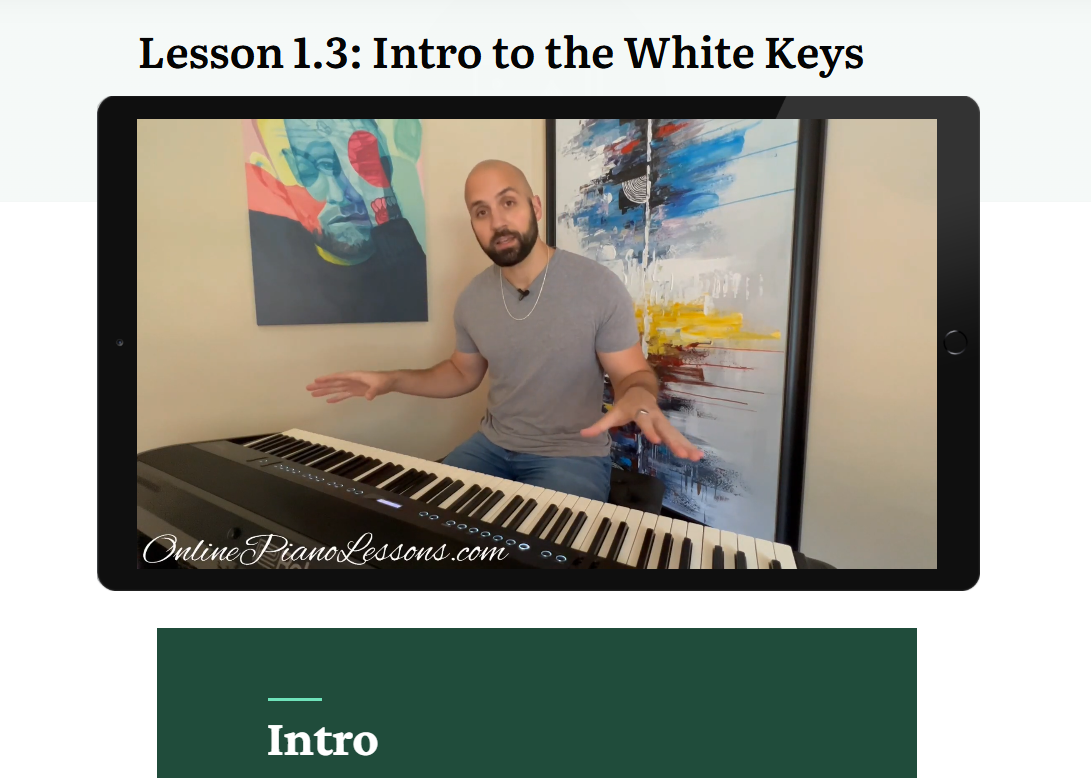
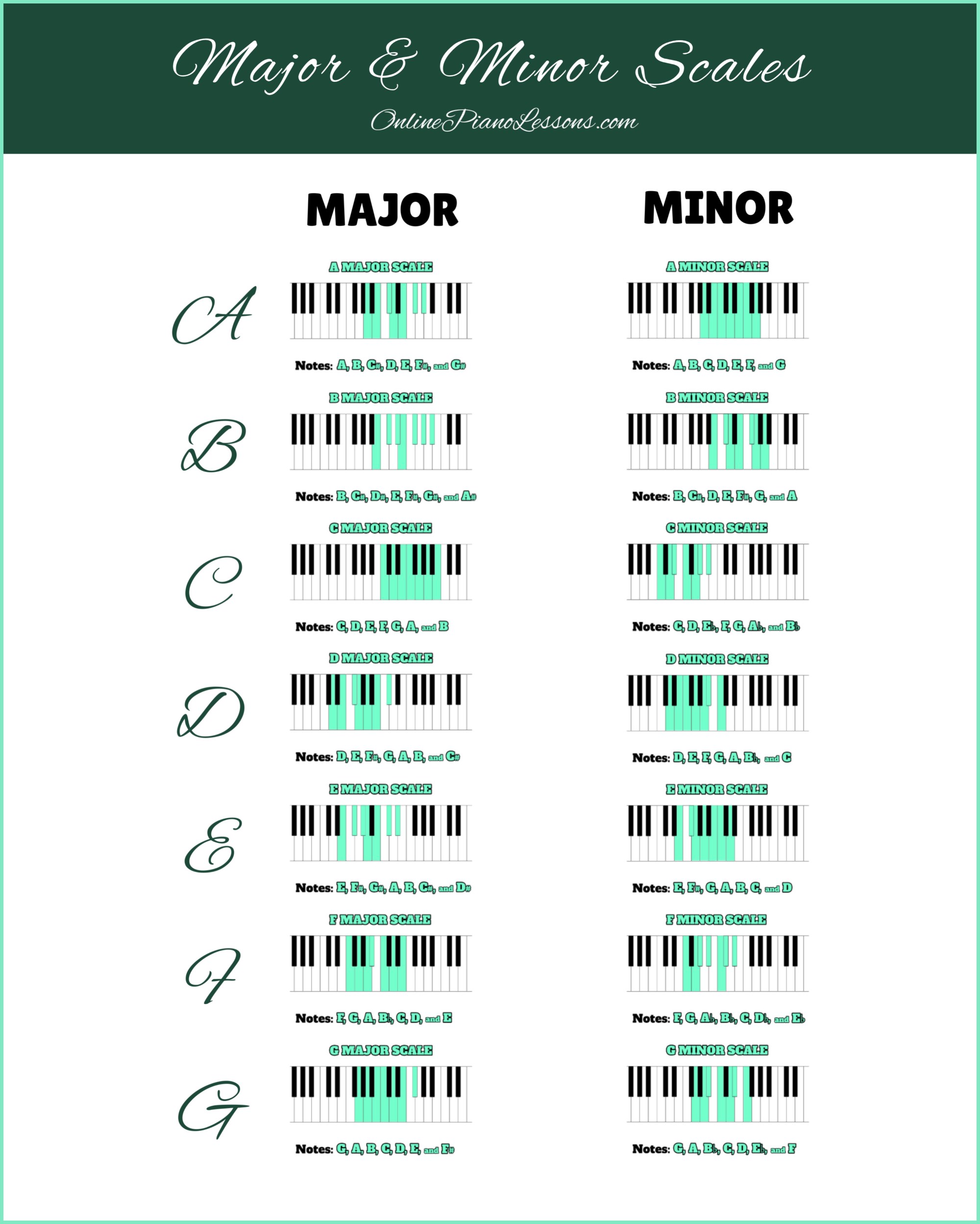




 Hi, I'm Thomas, Pianist Composer,
Hi, I'm Thomas, Pianist Composer,  I love playing piano, creating new melodies and songs, and further developing my online piano course and making updates/additions to my site OnlinePianoLessons.com!
I love playing piano, creating new melodies and songs, and further developing my online piano course and making updates/additions to my site OnlinePianoLessons.com!  Now that is what I call fun!
Now that is what I call fun!

